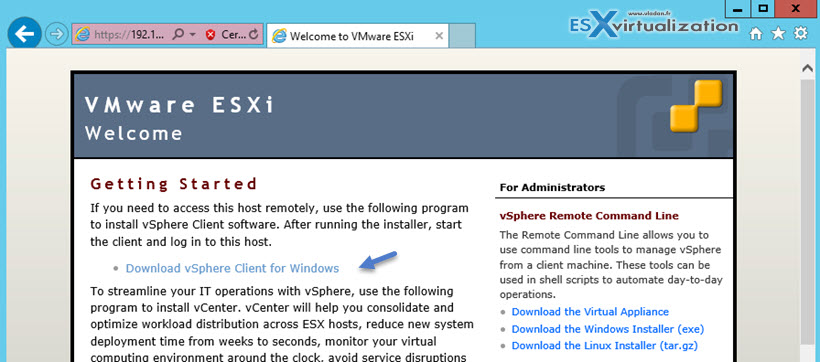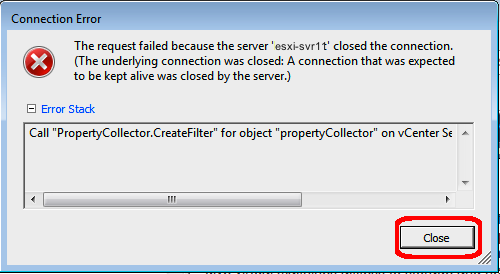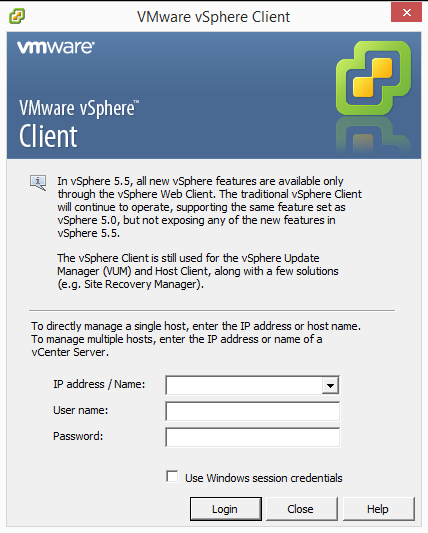Vsphere Fat Client
Windows 10 - Install The VMware Virtual Infrastructure Client. Locate and extract the actual VI client install file (in the bin folder). VI client requires.
Free music. Now you are free to download music, listen to music online and gather your own collection of free mp3 music downloads.
vSphere 6.5 brings with it significant changes to the vCenter Server management clients including the vSphere Web Client and new HTML5 based vSphere Client. A detailed FAQ can be found here in this KB article; a summary of the changes are given below in this blog post.
vSphere Client (HTML5):
VMware agrees that Flash is not the solution for the long-term. Our long-term direction is to utilize HTML5. In vSphere 6.5, we have released a supported version of an HTML5 based web client which we call “vSphere Client”. The vSphere Client is part of the vCenter Server (both appliance and Windows) and is configured to work out of the box. You can access this client by this URL – https://<FQDN-or-IP-Address-of-VC>/ui. This HTML5 based client was originally released as a fling back in March 2016 and has been releasing a new version every week.
- You can access the list of features/functionality not available in the vSphere Client released in 6.5 by the link in the vCenter Server’s landing page (https://<FQDN-or-IP-Address-of-VC>/), which links to this article
- Another source to check if a feature is available in the vSphere Client is the changelog section of the Flings page. The vSphere Client released in version 6.5 is using fling bits as of v2.7.
Figure 1: HTML5 based vSphere Client
Updates to the supported version of the vSphere Client will probably be released on a quarterly cadence, but we will continue to release new features every week via the Fling. Note that Administrators may look to the vSphere Client Fling to get the latest features but the Fling remains UNSUPPORTED. It will take some time for the vSphere Client to achieve feature parity, but we are also continually working to make the vSphere Client a great user experience. Progress can be seen on the Fling site as it develops, and is the best measure available. We encourage you to try the Fling and give us feedback on any missing features you want to see sooner using the built-in feedback tool.
vSphere Web Client (Flash/Flex):
The vSphere Client (HTML5) released in vSphere 6.5 has a subset of features of the vSphere Web Client (Flash/Flex). Until the vSphere Client achieves feature parity, we might continue to enhance and/or add new features to vSphere Web Client.
In vSphere 6.5, we have made significant improvements to enhance the user experience of the vSphere Web Client. Some of the key changes to this client are:
- Live Refresh improvements
Figure 2: Live refresh enabled sections of vSphere Web Client
One of the prior challenges for vSphere Administrators was that they were unable to see the real time status for their environment, causing them to continue using the Legacy C# Client or abuse the Refresh button – both of which can cause extreme load on vCenter Server. Live Refresh in the vSphere Web Client 6.5 allows vSphere Administrators to now see the current state of the inventory. For example, VM power states and tasks for all users now update in real time allowing the vSphere Web Client to act as a source of truth for the state of the environment. Most of the views (Inventory tree, Alarms, Summary, Lists and Tasks) reflect the near instantaneous updates.
- Client Integration Plugin (CIP) removal
Figure 3: Deploy OVF Template wizard without CIP showing the warning sign for additional file selection.
In vSphere 6.5, the vSphere Web Client will have no dependency on CIP as it exists today. There is also no dependency on CIP to install and deploy the vCenter Server Appliance,which allows us to deliver a cross-platform installer that runs on macOS, Linux, and Windows. Not all CIP functionality could be replaced by native browser functions, however. The “Use Windows Session Authentication” functionality as well as SmartCard login require the new slimmed down Enhanced Authentication Plugin (EAP). All other functions (File upload/download, Deploy OVA/OVF, Content Library import/Export) are replicated without CIP and function natively in a web browser. It is important to note that OVF deploy functionality has slightly changed with the removal of CIP. A user has to select all the related files of the OVF (.ovf, .mf, .vmdk unlike just the .ovf file before) as shown in Figure 3 above. This change is due to technical limitations on accessing local files by the browser.
- Navigation improvements
Figure 4: Navigation improvements in vSphere Web Client
The default view in the vSphere Web Client is now Hosts and Clusters instead of the Home page. We also stick with the Inventory Tree through other actions such as performing searches to provide a more intuitive and seamless experience.
The Related Objects sub tabs have been flattened and brought up as top level tabs, thus reducing the number of clicks required to go to the VMs or other objects.

Tab reorganization – the Manage tab is renamed to Configure and sub-tabs under the Manage tab are now flattened which also reduces number of clicks.
- Custom attributes
Figure 5: Edit custom attributes dialog which can be invoked from the Summary page portlet

Based on popular demand, we have brought back the custom attributes to the vSphere Web Client. You can view and edit the custom attributes in the summary page portlets.
- Performance enhancements –
vSphere Web Client performance has been enhanced to improve the overall experience. A few of the areas which we extensively optimized are Login time, VM Configuration (Edit Settings), VM Migration and VM Provisioning (New VM, Clone VM).
Legacy C# Client:
VMware announced in May 2016 that the Legacy C# Client (aka thick client, desktop client, etc) will no longer be available with the vSphere 6.5 release. The Legacy C# Client connection to vCenter Server 6.5 or ESXi 6.5 host is untested and is not supported. (Reference – Goodbye vSphere Client for Windows (C#) – Hello HTML5)

The Legacy C# Client will still be supported with all previous non-EOL’d vSphere versions. For example, the Legacy C# Client will still be available and continue to work with vSphere 5.5 and 6.0. Starting with vSphere 6.5 onwards, we will not ship a newer version of this client.
Vmware Fat Client Download
For more details about the benefits of vSphere Web Client over the Legacy C# Client, refer question #6 and #8 in this KB article.
Dennis Lu covered this topic on changes to vSphere clients in his roadmap presentation at the VMworld. You can watch the recording of that session here:
We still need your help:
Figure 6: vSphere Client’s built in feedback tool
We have made a lot of improvements to the vSphere Web Client and the new HTML5 based vSphere Client based on your feedback. The vSphere Client comes with a built in feedback tool (Smiley icon on the top right corner) you can use to send us direct feedback. All of the UX, product and engineering teams monitor this feedback, and use this data to prioritize next set of features and make improvements. Hearing your voices through this tool and other channels has helped drive the vSphere Client in the right direction. Even if you don’t have vSphere 6.5 yet, you can use the Fling to manage vCenter 6.0 and provide us feedback.
I think you're getting a bit confused here. There are two options for VCentre - On windows or on an appliance, the VCentre install on Windows is largely end of life so you're better off installing the appliance.
As for the thick client (Sometimes called the C# client or the installable client), that is also end of life.
Vsphere Client 6 Download
Now, there are also two web clients - the flash version that has all the functionality of the thick client and is horrible to use and the HTML 5 client which has 80% or so of all the functionality of the flash version and is simply gorgeous and lovely.
To complicate things further - the HTML 5 client is only available on VCentre 6.5, it's possible to use on 6.0 via fling (VMware beta type software). It is not possible to use on 5.5 which only has the flash client.
In short, move to 6.5, install the VCSA appliance and use the HTML 5 client for everything that you can. Use the flash client if you must.